#NEW CINEMA PARADISE
Explore tagged Tumblr posts
Video
tumblr
本田美奈子 - ニュー・シネマ・パラダイス 愛のテーマ Minako Honda - NEW CINEMA PARADISE Ai No THEME
#el.nakamori#El Nakamori#Naka! Naka! Mori!#Naka Naka Mori#本田美奈子#NEW CINEMA PARADISE#Minako Honda#Honda Minako#アイドル歌謡曲#JPOP#JMUSIC#ミュージカル#声楽曲#クラシカル#クロスオーバー#歌手#アイドル#女優#ニュー・シネマ・パラダイス 愛のテーマ#ニュー・シネマ・パラダイス#エンニオ・モリコーネ#Ennio Morricone#Nuovo Cinema Paradiso
15 notes
·
View notes
Text

The St. Marks Cinema at St. Marks Place and Second Avenue (1984)
Photo by David Godlis
#St. Marks Cinema#nyc#new york#St.Marks Place#second avenue#stranger than paradise#gregory’s girl#the terminator#1984
8 notes
·
View notes
Text
ZB1 ZHANG HAO + KIM TAERAE ✧ TikTok Update ✧ "GOOD SO BAD" Challenge
#zb1#zerobaseone#zhang hao#hao#kim taerae#taerae#zb1 taerae#julyz#ohraez#video#tiktok#ig#instagram#good so bad#good so bad challenge#cinema paradise era#favorite#THIS SONG???? SOUNDS LIKE????? MY NEW FAVORITE SONG?????#HOLY FUCJGHFDJGH#IT SOUNDS SOOOOOO GOOD AND THIS CHOREO IS LOVELY#HAORAE SO CUTE
5 notes
·
View notes
Note
https://x.com/gdh559/status/1812685844748324984
The Cover looks like "Call me by your name"

SORRY ANON I SAW JEFF WITH A SEPTUM RING AND I MUST HAVE BLACKED OUT FOR AN HOUR OR A DAY BECAUSE THE NEXT THING I KNEW I WAS SHOVELING DIRT INTO MY MOUTH. GODDDDDDDDDD
for some reason this movie poster actually reminds me of a version of the tree of life, although it’s entirely possible it’s just because they both have.. a tree ;;;;;;;; but the angle feels very similar to me, and while the tree of life is obviously a very different story and has a lot of christian elements to it, so i would never compare the two movies, i think it’s gonna be interesting to see how the paradise of thorns will treat similar themes, like death, and grief, and nature, and family
ANYWAY THIS IS ALREADY GIVING SUCH UNPRECEDENTED UNPARALLELED UNMATCHED LEVELS OF SYMBOLISM VISUALS AND COLORS I HOPE WE'LL BE ABLE TO WATCH IT SOON!!!!!!!!!!!!
#THE RED THREAD WRAPPED AROUND THE TREE AND THE DURIANS#CINEMA!!!!!!!!!!#THANK YOU FOR KEEPING ME UP TO DATE WITH NEWS ABOUT THIS MOVIE ANON!!!!!!!!!#hope you're having a wonderful day!!!!! 💜#the paradise of thorns#jeff satur#m: ask
4 notes
·
View notes
Text



Palace of the Republic, Berlin
The right to work at a job of one’s own choice was guaranteed by the East German constitution (Aus erster Hand, 1987). While there were some (mostly alcoholics) who continuously refused to show up for jobs offered by the state, their numbers represented only about 0.2% of the entire East German work force, and only 0.1% of the scheduled work hours of the rest of the labor force was lost due to unexcused absences (Krakat, 1996). These findings are especially noteworthy, given that people were generally protected from being fired (or otherwise penalized) for failing to show up for work or for not working productively (Thuet, 1985). The importance of the communist characteristic of full employment to workers is reflected in a 1999 survey of eastern Germans that indicated about 70% of them felt they had meaningfully less job security in the unified capitalist country in the 1990s than they did in communist East Germany (Kramm, 1999)
The Triumph of Evil, A. Murphy (2002)
The GDR had more theatres per capita than any other country in the world and in no other country were there more orchestras in relation to population size or territory. With 90 professional orchestras, GDR citizens had three times more opportunity of accessing live music, than those in the FRG, 7.5 times more than in the USA and 30 times more than in the UK. It also had one of the world’s highest book publishing figures. This small country with its very limited economic resources, even in the fifties was spending double the amount on cultural activities as the FRG. Every town of 30,000 or more inhabitants in the GDR had its theatre and cinema as well as other cultural venues. [...] Subsidised tickets to the theatre and concerts were always priced so that everyone could afford to go. Many factories and institutions had regular block-bookings for their workers which were avidly taken up. School pupils from the age of 14 were also encouraged to go to the theatre once a month and schools were able to obtain subsidised tickets. [...] All towns and even many villages had their own ‘Houses of Culture’, owned by the local communities and open for all to use. These were places that offered performance venues, workshop space and facilities for celebratory gatherings, discos, drama groups etc. There was a lively culture of local music and folk-song groups, as well as classical musical performance.
Stasi State or Socialist Paradise? The German Democratic Republic and What Became of It, Bruni de la Motte and John Green (2015)
Work itself was elevated to a place of pride and esteem and, even if you were in a lower paid job, you were valued for the work you did as a necessary contribution to the functioning of society. The socialist countries were also designated ‘workers’ states and it was not merely an empty phrase when the GDR government argued that the workers, who produced the commodities that society needed, should be placed at the forefront of society. Those who did heavy manual work, like miners or steel workers, enjoyed certain privileges: better wages and health care than those in less strenuous or dangerous professions. The GDR had one of the most comprehensive workers’ rights legislation of any other country in the world. From 1950 onwards, there was a guaranteed right to work. This right applied to everybody, including disabled people and those with criminal records. Employers were made responsible for the training and integration of everyone. This meant that everybody felt they had a place in society and were needed. This was particularly important for disabled people and those who wanted a new start in life after being convicted of a crime. Working people were under a much more relaxed discipline in the workplace. Because there was job security and it was almost impossible to be sacked, an authoritarian discipline was difficult, if not impossible, to achieve. In Western countries work discipline is invariably enforced by the implicit threat of job loss. In the GDR, only in cases of serious misconduct or incompetence would employees be sacked. There were individual cases where employees were sacked illegally for what was considered ‘oppositional’ or ‘anti-state behaviour’, but usually the sanction would involve demotion or being transferred to a different workplace. This job security gave employees a sense of confidence and a considerable power in the workplace. It meant that workers could and would voice criticism over inefficiencies or bad management without having to fear for their job. Job security and lack of fear about losing it was probably one of the greatest advantages the socialist system offered working people. Even in cases where a worker was sacked from one job, other alternative work would be offered, even if not on the same level. The other side of the coin was that there was also a social obligation to work - the GDR had no system of unemployment benefit, because the concept of unemployment did not exist.
Stasi State or Socialist Paradise? The German Democratic Republic and What Became of It, Bruni de la Motte and John Green (2015)
400 notes
·
View notes
Text
On March 1, 1984, a short article titled "Imprisoned Armenian Dies" appeared in the New York Times: “Gourgen Migirdic Yanikian, an Armenian author and engineer who killed two Turkish consular officials in California in 1973, died Monday in prison of natural causes. He was 88 years old. He was sentenced to life in prison in July 1973 for first-degree murder."
But who was this man? And why did he commit this "crime"?

Gourgen Yanikyan was born on December 24, 1895, in the city of Karin, Western Armenia, into a traditional Armenian family. Gourgen was six months old when the hamidian massacres began, claiming the lives of approximately 300,000 Armenians. His father had good relations with the Persian consul in Karin, and with the consul's help, the Yanikyan family found refuge in the Persian consulate, escaping the massacres. After two weeks of safety, they were transferred by a mountain road to the village of Kyotah near Kars on the consul’s orders. Suddenly, it was discovered that Gourgen was missing. He had fallen on the road from his mother’s arms that were numbed from the cold. Despite the danger, his mother and brother Hakob went back and, after walking about six kilometers, found Gourgen nearly lifeless. They revived him with the warmth of their bodies.
Six years later, the mother returned to Erzurum with Gourgen and Hakob, intending to take back the money and documents hidden in their barn back. While digging, two turks arrived, captured Hakob, beheaded him, and took the iron chest. The mother and Gourgen witnessed everything from their hiding place. A terrified Gourgen tried to scream, but his mother held his mouth shut. Gourgen never forgot this tragedy throughout his life. For political reasons, he became a Persian citizen and later moved to Switzerland with his family, where he continued his education, which he later pursued in Tbilisi and Moscow.
Like many Armenians of his time, he experienced the devastating effects of the massacres committed by the turks against Armenians. He lost 26 family members to the Armenian Genocide of 1915, as well as his homeland—Western Armenia.
Although Gourgen was far from his homeland, the injustice of the genocide never left him. He had exhausted all peaceful means to inform the world about the genocide and hold turkey accountable for the atrocities they committed.
He chose cinema as the means to achieve his goal: “Our plan was very simple. With our personal funds, we secretly planned to make a film showing the world the sufferings of our people and the barbaric turkish massacres, not forgetting the Armenian genocide and the conspiracy of so-called civilized nations against our rights."

Yanikian's factual book "Paradise" (originally in English), which his wife Shushanik had titled, became the basis for a screenplay. Several foreigners joined the film project, and they shot 20 hours of material depicting turkish atrocities with striking authenticity.
"The film was to be shown simultaneously in the capitals of three different countries, free of charge. Flyers explaining the purpose and our demands were to be distributed with the tickets… The goal was to return the land stolen from the Armenian people to its rightful owners and provide compensation for our two million victims. Many individuals were to join the cause once the film was ready."
Despite the strong dedication to completing "Paradise," the endeavor was unsuccessful because U.S.-Turkey alliances and strategic interests were prioritized, and the US government hindered the production of the film.
Yanikyan, by then old but not despairing, had spent decades using every peaceful means to punish the perpetrators of the Armenian Genocide and avenge his compatriots, but he ultimately felt compelled to choose an alternative.
"In all my writings, I always defended the belief that violence should disappear from our lives. But when all of this happened and humanity and the world remained silent about the Armenian Question, I made the decision to take action in order to bring the Armenian cause to the attention of humanity and world governments."

On January 27, 1973, at the age of 78, Gourgen Yanikyan, without hesitation, fired 13 bullets at the turkish consul and vice-consul in Santa Barbara in his room at the "Baltimore" hotel. Following a highly publicized trial, Yanikyan was sentenced to life imprisonment, and in 1984, with a clear conscience, he passed away into eternity.
But his sacrifice was not in vain: the Armenian Question was finally brought back from the dusty archives of history. By sacrificing his freedom, Yanikyan ignited a movement. His act became the catalyst for a wave of Armenian activism, inspiring the creation of ASALA, who would go on to fight for the recognition of the genocide.
Everyone condemns violence but, alas, it is the only language the world understands.
#in my eyes he's a true hero#break the chain of ignorance#armenian history#armenian genocide#turkish crimes#azeri crimes#gurgen yanikyan#world history#world politics#armenia#armenian culture#genocide#cinema#asala
166 notes
·
View notes
Text
Heisei/Reiwa Kamen Rider Bike Riding Time research

Hello there! Does anyone remember from a little while back when this image was going around?
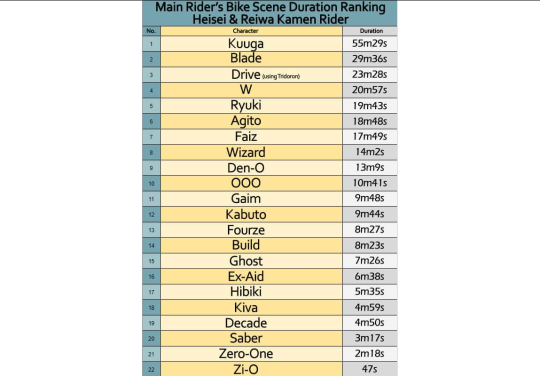
For a while, at least in fan communities I frequented; this was quite infamous for showing just how sharp a decline Kamen Rider's namesake had become in the last few years, with the absolute nadir of the Heisei 20th anniversary Kamen Rider using his bike for a total of 47 seconds (and also, on the other end; just how much Kuuga would not get off his bike)
Obviously, it's been a few years since Saber now; and I've found myself wondering from time to time exactly how the Riders since then have fared, especially since both Geats and Gotchard have garnered a reputation of sorts for putting a bit more emphasis on the bikes and feeling like they have more screentime than your Zero-Ones and your Sabers.
So! I went looking and found the source. This extremely dedicated Japanese poster called Yamashita Radio who of course I will be basing the majority of this on, including his rules and his counting. And when I say 'dedicated' I mean that at one point he lost all his data so he just counted Kuuga through Saber all over again. MAD respect for this man! I highly recommend a full readthrough of this 5-part post at one point because it's very impressive and interesting stuff in my opinion
One other interesting point is that that chart there? That's main rider only; and also includes any riding they did as civilians. There is a separate chart for all motorbike riding in the show as a whole; including other riders, including monsters, including even just random civilians! For posterity, I think it's important to post that chart for comparison with the main rider one -- I've colour coded here so that red is Heisei 1 (Kuuga-Decade), green is Heisei 2 (W-Zi-O) and yellow is Reiwa (Zero-One onwards). Main rider only on the left, all biking on the right.

Up front there are some absolutely fascinating observations to make here - Zero-One had the least bike scenes of any show! Brand new era of Kamen Rider! - but I think I've talked about the past enough. With all this said and what I feel is a very important plug to make, let's get into the meat of this -- how do Revice, Geats and Gotchard compare to previous shows?
Rules
... okay, yeah, sure; let's quickly establish a baseline first. As I'm going off of Yamashita's work, I'm also going by all his rules; it's a good thing I agree with all of them because I kinda didn't want to completely redo the count of every season!
TV Show ONLY! No movies, no TTFC specials, no HBVs, no V-Cinema, none of it. The main reason given is that, uh, Paradise Lost has a 100+ bike scene near the start so that's too much of an advantage -- fair enough! Personally I also think it's more interesting, because movies generally have more budget and allowances for bike scenes so those tend to be the same. Maybe a separate count would still be interesting, but I think including movies would flatten out the times too much and make the data pretty uninteresting
No openings! Agito has too much of an advantage
Non-transformed states count the same as transformed states. Godai riding a bike is the same as Kuuga riding a bike.
All motorcycles are treated equally! Mopeds and even CG scenes and bikes are allowed
Other vehicles such as cars, trains and even bicycles and hoverbikes are excluded. Two big exceptions are made for Drive and Revice as they do not have a main motorbike otherwise, but this does exclude things like Gaim's Dandeliner, many of the Oni in Hibiki's transport vehicles, Den-O's Den-Liner, Gotchard's Steamliner and Madwheel and Decade's Agito Slider
Transformations of the bike still count as long as it's being ridden. The Boostriker turns into fox mode while you're riding it? That's fair game
Flashbacks and other repeat footage ("previously on" segments etc) don't count of course. But in cases where it's clearly stock footage but it's still a new event, like the many Ryuki Rideshooter scenes, that's still counted
Count from the moment the bike is straddled to the moment the bike is gotten off, and everything in between. Scenes where the bike isn't technically visible - such as close-ups of the rider's face, or cutting to another character's reaction - are still counted if it's all the same scene
Revice

3m21s (2m23s for Revi only)
Oh lucky me, this was actually done for me! Yamashita made a small update after Revice finished to add this. I just went over and double checked it.
At 3m21s, Revice is at this point the series with the 2nd least amount of bike riding; above Zero-One and below Zi-O. For Revi alone he's in 3rd least; above Zero-One and below Saber. Happy 50th anniversary!
An interesting note here is that Ikki never rides Vice Ptera untransformed -- concerns over the actor's safety, maybe? Daiji also pulls in 58 seconds for the show on his own motorbike, but abandons it completely after episode 13; only bringing it back for the summer movie (which is also the only place he rode it as Live). Interestingly, the 12 seconds he rides it with Sakura in episode 13 is the only time he uses it in the show after becoming a Rider. The skateboarding scene in episode 7 for Jackal Form goes on for over a minute, but unfortunately can't count for this...
I think most people expected Revice to place quite low, though. So let's move on to a show I think a lot of people expect to place higher.
Geats

4m05s (3m45s for Geats only)
I keep repeating it, but this is a show where it seemed a lot of people got the impression of the bike having more importance than before. I think there's a lot of aspects that come together into that -- the bike being tied to a specific 'special' item that's even part of the main rider's main form, the upgrade forms going off of that, and the bike being used in prominent scenes including in the first episode. Geats even arrives on it in his Revice summer movie cameo!
But ultimately if you look at riding time, Geats ends up in 3rd place for overall bike time; above Revice and below Zi-O, while for main rider only Ace ends up in 5th last; above Saber and below Decade. As such he ends up being the main Reiwa Rider to use his bike the most.
This is where I started splitting main rider and untransformed rider in my personal tracking charts, just for fun -- I actually couldn't do that for Revice because as said Ikki never rides anything untransformed except his bicycle. Until episode 11 Ace actually just slightly edged out Geats for having more bike time which was enjoyable to see.
A very interesting thing happens in regards to the Boostriker's transformed state. I decided not to include finishers involving it unless the Rider is specifically riding it -- and the one and only one to do so was Buffa in episode 6, accounting for every single second he rode the machine. He had a penchant for using the buckles' weapons in ways he wasn't supposed to, and he kept up that rule even when the 'weapon' was a bike.
Geats spends a decent amount of time in the final episode sitting on his bike while talking to Regad and the other Riders, and that really saved the show's overall times.
Gotchard

5m09s (2m32s for Gotchard alone)
According to production blogs, Gotchard had a stated aim of using the bike more. Unfortunately it seems this didn't manifest itself in a very major way... but I think we did see more interesting uses of it! Spanner has his own bike (that like Daiji, he never rides transformed!), there's a version of Golddash from the future, other characters including Golddash itself ride rather than Hotaro at multiple points!
For 'others', the 3 seconds in Episode 2 is when Minato rolls up to deliver Golddash to Hotaro personally. Episode 9's 5 seconds have Renge (with Sabimaru in the back) riding it to deliver Hotaro's cards to him in Kyoto.
Spanner shockingly saved the series' overall time here in a similar way to final episode Ace, by sitting on his for an extended period of time during his conversation with Lachesis at the start of episode 47.
While it's not a very long scene nor did it change anything for the rankings, the bike scene in the final episode that just aired is notable for an extremely rare instance of a Rider Machine being ridden by a Kamen Rider's final form. To my knowledge this has previously only been done by Agito, Den-O and Revice (the latter in a movie). Fittingly for a show where part of the direction was inspired by Agito, both Agito and Gotchard do this Final Form bike scene in their final episodes.
And now, for the final count...

Gotchard ended up in 21st for overall bike time between Zi-O and Saber, but this was largely due to other characters; so Hotaro alone ended up in 22nd between Revice and Saber.
Overall we're now 5 shows in instead of 2, we can indeed see a very large dropoff in the Reiwa Era -- including Zi-O, the most recent 6 shows are all at the bottom of the list. This is especially notable when The next most recent series, Build, had 12m31s; almost double that of Saber's -- and this wasn't uncommon, with Ghost and Ex-Aid sharing similar times.
This was the main thrust of my research... but what say we go on a little addendum? Because when I mentioned Yamashita updated his post to include Revice in 2022, there was... one other series he saw fit to do a count for. One that was only halfway through, but nonetheless saw an impressive amount of bike riding time. He only got halfway, but what say I finish the job out of pure interest?



It is "Avataro Sentai Donbrothers"

The extremely normal 2022 entry into the Super Sentai series has a number of bike scenes. Some you may expect from Don Momotaro riding his CGI Enyarideon on his Palanquin for much of the first cour. Some of you might say that CGI shouldn't count, it's easy enough to animate together a scene than deal with road laws and such -- but does Kijibrother not count? Does Inubrother not count? Do none of the mech scenes count? It's a festival, people. Let's enjoy it.
Even aside from the CGI, Yamashita noted halfway through the show; that can't quite account for everything else. Sonoi has a bike he rides in multiple episodes, every time with a wheelie. Inuzuka twice within 4 episodes steals a bike and almost runs people over with it, as is perfectly fine for a hero. Don Kaito shows up with his own motorbike to promote his new book, which you should buy. For a show where it's not even in the name and for recent Sentai, there's an awful lot of riding going on.
Yamashita in his post speculates that part of this is Inoue's own habits -- as a man whose Toku experience largely consists of regularly writing for Kamen Rider in the 00s, it's natural to expect he would be inclined to write something like "Inubrother escapes the scene on a motorcycle..." as if it was second nature; as if that's nothing special for a modern show.
And I would be inclined to believe that... as such a habit is something that would likely get ironed out after a while; and sure enough, while bike scenes are frequent for the first half of the show, they disappear entirely from episode 23 to 43. It is at this point in my own count I thought we would simply never see a large bike scene from the show again, and the sheer fun of counting up Donbrothers would be lost.
And then... he appeared.
My saviour from the future.
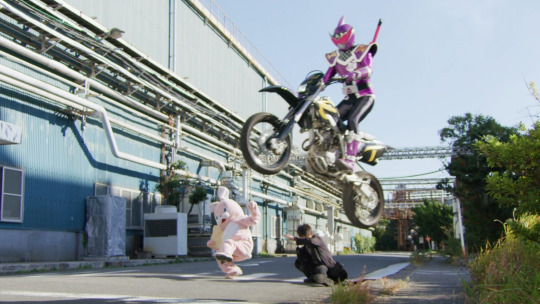
With a full uninterrupted 1 minute 15 second bike scene
I could hardly believe what I was seeing. I remembered the future episode but I had completely forgotten this was a part of it. When I started timing this episode I was leaving the house fairly shortly and I figured like the past 20 episodes this would be easy enough to count, and I was utterly bewildered. I should never have disbelieved for a moment.
With all that said... where does Donbrothers end up in full?

7m21s (4m23s for Don Momotaro alone)

This overwhelming record easily puts both Donbrothers and Don Momotaro in 20th place of their respective charts; beating all Reiwa Riders and Zi-O -- with Don Momotaro even coming close to dethroning Kamen Rider Decade's riding time!
This is where we stand, my companions. In an era where Kamen Rider's biking time is lower than ever before and shows no sign of significant recovery, Donbrothers swoops in to steal its glory. Never lose faith. The festival never ends
203 notes
·
View notes
Note
Heyy may I ask which documentaries on various club scenes you've been watching? Really interested in the topic :)
Hey, for sure! I'll link them all. Some of these are about clubbing, and some are more about electronic music, but understanding electronic music is essential for understanding clubbing. So I'm like really obsessed with the Hacienda, which was this big Manchester nightclub in the 80s during the Madchester era, acid house boom. You got this BBC documentary (The Hacienda - The Club that Shook Britain) and also a 1990 doc on Madchester that's a nice little introduction. One of my favourite youtube channels is Trash Theory, they did a great video on Madchester and also New Order's Blue Monday, which is relevant bc New Order basically financed the club so maybe that'll interest you as well. There's also Peter Hook's book about it that I actually still haven't read but it's next up on my to read list. I would also recommend the movie 24 Hour Party People from 2002 that I really love. I'm linking everything I've seen, some acid house, raving, disco, house, techno etc. docs, video essays, other videos and so on. I think a good start, and then from here you'll find more stuff :)
Everybody In The Place: An Incomplete History Of Britain 1984-1992 by Jeremy Deller
The Chemical Generation
Acid House 1988
The Summer Of Rave 1989
Trailblazers: Acid House
Dance Britannia - Acid House
BBC Everyman - E is for Ecstasy - Rave Documentary 1992
The Rave Years - With Keith Flint & Richard Russell
I Was There When House Took Over the World
How House Music Was Born
Pump up the volume: A history of House music
Maestro Documentary - The History of the Paradise Garage
What is House? An Insider's Look at Dance Music - 1991
The Story of When House Music Went Global
When Disco Ruled the World BBC
When Disco Ruled the World VH1
Modulations - Cinema for the Ear
Better Days: The Story of UK Rave
Synth Britannia
We call it techno! A documentary about Germany’s early Techno scene and culture
Sound of Berlin Documentary
Sub Berlin - The Story of Tresor
And then there's also a bunch of real footage you can find on youtube by just typing 80s clubbing or sth like that and it's just so fun.
64 notes
·
View notes
Text

Forever Isn't Enough Series
Hi! I hope you enjoy my work :)
MDNI! (Contains Smut* turning on Mature content community labels on your account may be required)

YOU'RE MINE *
Trent Alexander-Arnold x Reader | 30 Chapters - Complete ✨
↳ While you daydreamed about his face an ocean apart, he had no idea what yours was about to do to him. With a twist of fate and the heat of summer, a new relationship would completely ransack his heart - Everyday heavy with the thought of one another, neither of you were going to let the unexpected love of your life go. You were going to be his, you were his, and you were going to stay his.
Read Now! ♡

OURS *
Trent Alexander-Arnold x Reader | 30 Chapters - Complete ✨
↳ You were his and he was yours but what would it be like adding one more? Thrust into a whirlwind romance you never could’ve imagined that became your forever love. You continue building a new life across the pond with a very beautiful Scouser. A sequel to the ‘You’re Mine’ fic.
Read Now! ♡
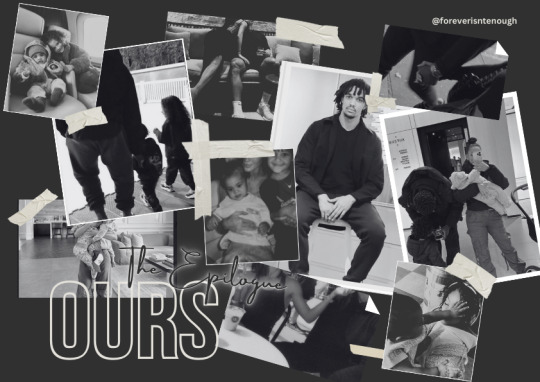
THE EPILOGUE *
Trent Alexander-Arnold x Reader | 3 Parts - Complete ✨
↳ A conclusion to what has happened in the ‘You’re Mine’ sequel 'Ours'
Read Now! ♡
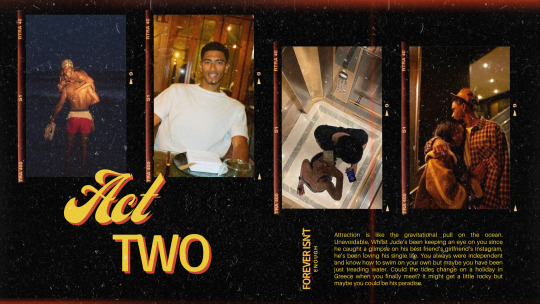
ACT II * Jude Bellingham x Reader | Complete ✨
↳ Attraction is like a gravitational pull that is undefinable and unavoidable. Unbeknownst to you, Jude had been keeping an eye on you since he caught a glimpse on his best friend’s girlfriend’s Instagram but he’s been loving his single life. You always were independent and know how to swim on your own but maybe you have been just treading water. Could the tides change on a holiday in Greece when you finally meet? It might get a little rocky but maybe you could be his paradise. ‘Act II’ is interconnected to the 'You’re Mine' and 'Ours' Series but can read it independently.
Read Now! ♡
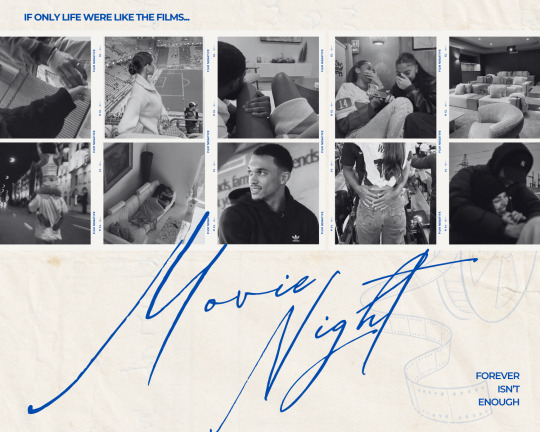
MOVIE NIGHT*
Trent Alexander-Arnold x Reader | In Progress.
↳ If only life was like the movies. For years, you’d flirted with the idea of something more with Trent, your brother’s best friend. You'd always danced around the edges of something more with him, sharing flirty moments that felt like scenes straight from the cinema. You had been silently desperate for the main character of your life’s film to finally get the boy but you knew moments like that were saved for Hollywood. The lines were clear; you were always going to be his mate’s little sister. So what happens when you go off script? In a whirlwind of passion, secrets, and stolen moments, you're left wondering: will you and your brother's best friend get the happy ending you've been waiting for, or was it never meant to be more than a fantasy?
Read Now! ♡
#trent alexander arnold#trent alexander arnold x reader#trent alexander arnold imagines#taa x reader#footballer x y/n#footballer x reader#trent alexander arnold smut
36 notes
·
View notes
Text
what i read in jul. 2023:
(previous editions) bold = favourite
race, gender, sexuality
transphobia in new zealand is making the shift from online to real life
mrt jackets: the naked truth behind women covering up on public transport (singapore)
do not forget them (canada)
a mother's worst nightmare (usa)
when barbie went to war with bratz
the 1975, matty healy, malaysia, and the problem with saviour complexes
photos of samoa’s fa’afafine community that reshape coloniser art
politics & current affairs
‘all that we had is gone’: my lament for war-torn khartoum (sudan)
paradise island lombok, its poisoned gold, and the children who suffer (indonesia)
ghanaian children wrongly taken in raids backed by us charity ijm
behind washington’s decision to supply cluster bombs to ukraine
lumumba’s tooth returned, racist logic of colonisation endures (drc/belgium)
operation trojan shield: the secret country that helped fbi wiretap the world
history, culture, & personal essays
the last place on earth any tourist should go
how the inventor of the first chatbot turned against ai
the horrors of pompeii
can barbenheimer bring cinema back – and save us from 40-hour tv series?
we are all animals at night
read 'em and weep: a reading list for criers
#studyblr#studyspo#university#productivity#literature#reading list#reading lists#student#studying#academia#dark academia#myresources
231 notes
·
View notes
Note
What is your most recent favorite show/movie/book? What is your most recent favorite treat for yourself?
hooooooo dear.
Okay, so my favourite comfort movie is Six Underground. It's a simple plot with endearing characters, found family, car chases, gratuitous violence, kicky tunes, and [spoiler] that I find cathartic. It's enjoyable, funny, and relaxing, with the perfect balance of clever and low brain work. Is it a master class of deep introspective cinema? No. But it *is*, in my opinion, the perfect action comedy.
My favourite book.... is... difficult. I don't think I could pick one. Inkdeath, the Pentagon chronicles, Eragon... hoo, and Leven Thumps, Cirque du Freak, Class A, the Alex Ryder series, Legend of Drizzt, the mortal instruments series, the Hell's Paradise manga, Fullmetal Alchemist manga, any Goosebumps book, The Hitchhiker's Guide to the Galaxy, the Percy Jackson series.... all happy memories, almost all on my bookshelf. Haven't read most since I was in school, though.
Favourite TV series... I'd have to say Elementary, Bones (until they jump the shark... if you know, you know), Dirk Gently's Holistic Detective Agency, Horrible History, Museum Mysteries, Midsommar Murders, The Twilight Zone of all eras, Poirot, aaaand... hell, most docuseries not written by crackpots.
And internet series and channels weren't mentioned but I'm throwing in Casual Geographic, Some More News, Ryan George, The Watcher, Buzzfeed Unsolved Supernatural, Game Changer, and MBMBaM.
Most recent indulgence was Garlic Bread ♡
106 notes
·
View notes
Text
🖇️BL WATCHLIST AUGUST
🎬Battle of the Writers - YOUTUBE - I finally had the time to start watching this but I'm not 100% on board yet.
🎬First Note of Love - GAGAOOLALA - I'm only in it for Jame Kasama my beloved and he hasn't popped up yet. :(
🎬Addicted Heroin - Jinloe's remake of Addicted has already garnered some controversy due to one of the actors being underage, but the trailer seems to suggest that they changed much of the tone of the original novel. This currently has no release for inter fans, but I'll keep you updated.
🎬I Saw You in My Dream - GAGAOOLALA - I trust Dee Hup with my life. But also Putter my beloved!
🎬Monster Next Door - WeTV | GAGAOOLALA - After years of third-wheeling and manifesting, Big Thanakorn finally got himself a main role. Thank you Kongthup I owe u my life!
🎬This Love Doesn't Have Long Beans - IQIYI (region-locked) | YOUTUBE - This might be too slice-of-life for me atm.
🎬4 Minutes - VIU - Not sure what to think of this quite yet, especially since I'm fighting for my life every week trying to find the uncut version. I'm also a bit miffed that BOC seems set to typecast Jet as the irredeemable villain. :(
🎬SunsetxVibes - IQIYI - Mos as a naga, Lin hallucinating a whole hook-up, JJ with the best faces... but that's about it.
🖇️CALENDAR (THAI BL ONLY)

🖇️UPCOMING
⭐The Paradise of Thorns - CINEMA - Technically, this is a queer movie and not a BL. Also, this will release in cinemas and on festivals first, so it might be a while before we can watch it.
🖇️FINISHED
🎬The Rebound - GAGAOOLALA - I'm going to miss this show. And I'm going to miss this version of Frank Thanatsaran.
🎬Knock Knock, Boys! - GAGAOOLALA - This show is definitely one of my favourites of 2024.
🎬Century of Love - GAGAOOLALA - I loved everything about this show. Except for the director who can go step on a lego.
➕ MDL | ABOUT | ALL WATCHLISTS | COMMENTARY & NEWS TAG | THAI BL NOVELS | BL INDUSTRY | UPCOMING | SPOOKY BL
#bl watchlist#upcoming bl#thai bl#jane watches stuff#this is the first time i've actively decided against watching some bl#simply because i don't have the time to watch them all#hopefully with col and rebound ending i can finally catch up#also lots of stuff this month that i probably won't watch#gmmtv and i are on a timeout rn#and jinloe and jumdee are on very thin ice#luckily there's another kongthup production to save the day
24 notes
·
View notes
Text
How’d They Do That?
Special Effects & Stunts of Silent Cinema - Part 1
This is the first installment of an open-ended series where I try to highlight and illustrate the work of special effects and stunt artists of silent filmdom. Using articles from contemporary fan and trade magazines, I’ll make gifs or dig up images and/or video clips to accompany the descriptions of how the sequences were executed.
My notations will be bracketed and highlighted in a different color. Hope you all enjoy! Fair warning: this is a long read.
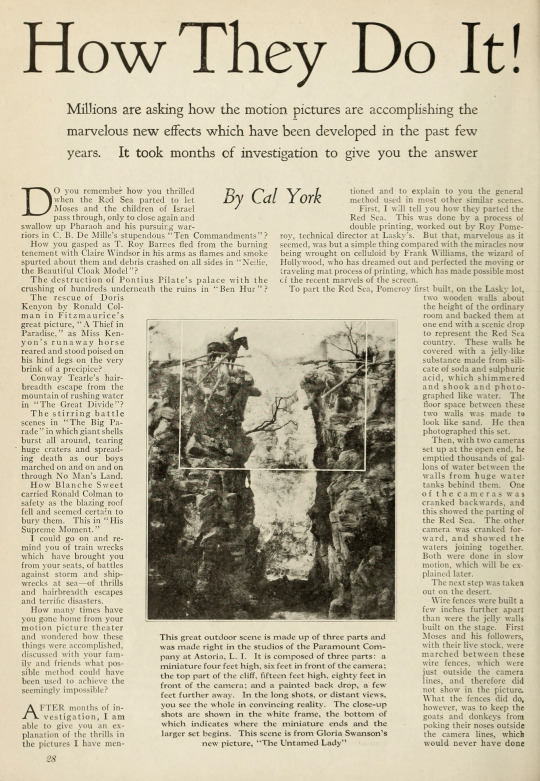

How They Do It!
[from Photoplay, April 1926]
by Cal York
Millions are asking how the motion pictures are accomplishing the marvelous new effects which have been developed in the past few years. It took months of investigation to give you the answer
DO you remember how you thrilled when the Red Sea parted to let Moses and the children of Israel pass through, only to close again and swallow up Pharaoh and his pursuing warriors in C.B. De Mille's stupendous "Ten Commandments" ?
How you gasped as T. Roy Barnes fled from the burning tenement with Claire Windsor in his arms as flames and smoke spurted about them and debris crashed on all sides in "Nellie, the Beautiful Cloak Model"?
The destruction of Pontius Pilate's palace with the crushing of hundreds underneath the ruins in "Ben Hur"?
The rescue of Doris Kenyon by Ronald Colman in Fitzmaurice's great picture, "A Thief in Paradise," as Miss Kenyon's runaway horse reared and stood poised on his hind legs on the very brink of a precipice?
Conway Tearle's hair-breadth escape from the mountain of rushing water in "The Great Divide"?
The stirring battle scenes in "The Big Parade" in which giant shells burst all around, tearing huge craters and spreading death as our boys marched on and on and on through No Man's Land.
How Blanche Sweet carried Ronald Colman to safety as the blazing roof fell and seemed certain to bury them. This in "His Supreme Moment."
I could go on and remind you of train wrecks which have brought you from your seats, of battles against storm and shipwrecks at sea—of thrills and hairbreadth escapes and terrific disasters.
How many times have you gone home from your motion picture theater and wondered how these things were accomplished, discussed with your family and friends what possible method could have been used to achieve the seemingly impossible?
AFTER months of investigation, I am able to give you an explanation of the thrills in the pictures I have mentioned and to explain to you the general method used in most other similar scenes.
First, I will tell you how they parted the Red Sea. This was done by a process of double printing, worked out by Roy Pomeroy, technical director at Lasky's. But that, marvelous as it seemed, was but a simple thing compared with the miracles now being wrought on celluloid by Frank Williams, the wizard of Hollywood, who has dreamed out and perfected the moving or traveling mat process of printing, which has made possible most of the recent marvels of the screen.
[Roy Pomeroy was head technical wizard for Famous Players-Lasky/Paramount (that is to say, he was their head special-effects engineer). We only know for certain about a handful of films that Pomeroy made specific contributions to, like The Ten Commandments (1923) and Wings (1927). As with many journeymen of the silent/studio era of Hollywood, the amount of films Pomeroy worked on was likely substantial, but many technical roles went uncredited at the time.]
To part the Red Sea, Pomeroy first built, on the Lasky lot, two wooden walls about the height of the ordinary room and backed them at one end with a scenic drop to represent the Red Sea country. These walls he covered with a jelly-like substance made from silicate of soda and sulphuric acid, which shimmered and shook and photographed like water. The floor space between these two walls was made to look like sand. He then photographed this set.

Then, with two cameras set up at the open end, he emptied thousands of gallons of water between the walls from huge water tanks behind them. One of the cameras was cranked backwards, and this showed the parting of the Red Sea. The other camera was cranked forward, and showed the waters joining together. Both were done in slow motion, which will be explained later.

The next step was taken out on the desert.
Wire fences were built a few inches further apart than were the jelly walls built on the stage. First Moses and his followers, with their live stock, were marched between these wire fences, which were just outside the camera lines, and therefore did not show in the picture. What the fences did do, however, was to keep the goats and donkeys from poking their noses outside the camera lines, which would never have done for in the double printing process the camera lines would become the walls of water. And it would never do for a donkey to shove his head through the Red Sea.
After Moses and his Children of Israel had passed through satisfactorily, under the grinding camera, they then photographed Pharaoh and his Egyptians madly pursuing in their chariots through the same fenced lane. And if the horses and chariots smashed out through the light wire fence, it was fine. for you will remember they were seen madly milling about before the walls of water finally obliterated them.
THEN when they put all together, by double printing, here is what they got:
First, a wall of water parted and left a lane of dry land in the Red Sea. (You remember the camera cranking backwards gave them the negative for this.)
Then Moses and his band were printed in passing along the space between the walls of water. After them, came Pharaoh and his warriors in full pursuit.
Right over these they printed the original negative of the waters rushing together, and this completely engulfed The Egyptians.

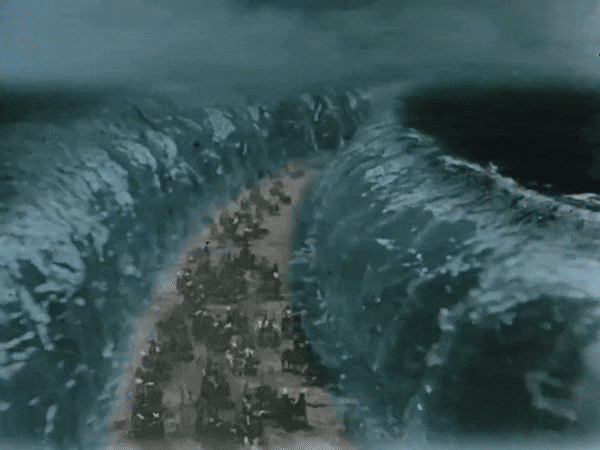
The only person to get wet in the closing of the Red Sea was Charles de Roche, who played Pharaoh. The blotting out of the King and his war chariot was not done by double printing but by trick photography, as it seemed necessary to the story of give this incident more personal drama.

The method used was this: DeRoche and his horses and chariot were placed on a treadmill. The camera was on a platform facing them. Over DeRoche's head and out of sight of the camera was a huge water tank, with a water chute projecting from it. This chute gave into a tank between DeRoche and the camera, but below the level of the camera line. While DeRoche whipped his horses like a madman on the treadmill and did all the acting necessary to being engulfed by water, the water in the tank was released and poured down in a torrent between him and the grinding camera, giving a perfect illusion. The only reason DeRoche got wet was because the water chute running above his head leaked badly.
Does this seem wonderful to you? It should. It is. And yet I tell you that it is simplicity itself compared with the moving mat.
Remember that in the "Ten Commandments" the double printing put the moving people into a vacancy on the film—the blank space left in the miniature between the walls of water. Also, that the double printing of the moving water over the Egyptians simply obliterated them.
READ ON BELOW the JUMP!
---
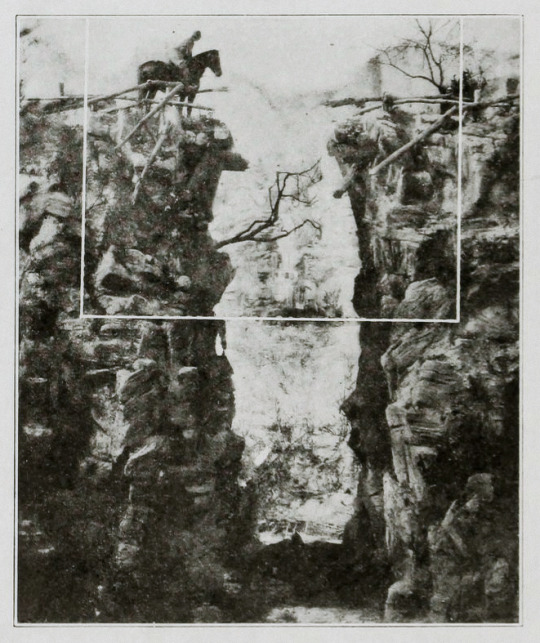
Photo caption: This great outdoor scene is made up of three parts and was made right in the studios of the Paramount Company at Astoria, L.I. It is composed of three parts: a miniature four feet high, six feet in front of the camera; the top part of the cliff, fifteen feet high, eighty feet in front of the camera; and a painted back drop, a few feet further away. In the long shots, or distant views, you see the whole in convincing reality. The close-up shots are shown in the white frame, the bottom of which indicates where the miniature ends and the larger set begins. This scene is from Gloria Swanson's new picture, "The Untamed Lady"
[The Untamed Lady (1926) is presumed lost, but luckily, a few images of this cliff-top sequence have survived.
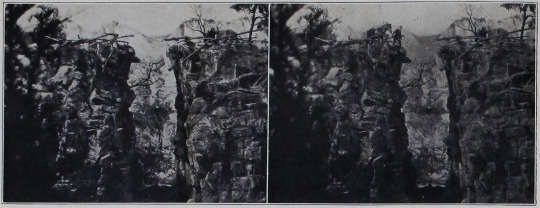
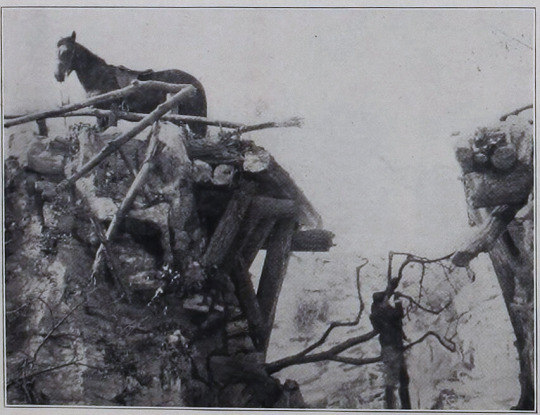
from Exhibitors Herald, 20 March 1926]
An amazing revelation of the latest discoveries of pictures which produce miracles before your eyes
---
But Frank Williams can put moving actors photographed in Hollywood into a moving background photographed anywhere in the world—put actual life and dramatic action into miniatures, which, during the previous years when they had worked with miniatures, seemed absolutely impossible.
[As you can gather from this article Frank Williams was a pioneer cinematographer and special effects artist. Williams was able to patent his moving matte process (and named it the Williams process) and it was an important effects technique used in film as as varied as Ben-Hur (1925), Sunrise: A Song of Two Humans (1926), The Lost World (1925), and The Invisible Man (1933). All of which are extant and easily accessible!
While it wasn’t in regular use for very long, the process was the basis for significant later developments in special effects photography, like green screening!]
Williams has made possible scenes that could never otherwise have been shot in motion pictures. It is not only that he has reduced the cost so that often he can give the producer scenes that would otherwise have been prohibitive because of building sets, etc. But he can give them scenes that couldn't be physically shot in any other way—such as a huge building crumbling and toppling in an earthquake and actually burying hundreds of people. It isn't only that he can make hairbreadth escapes without endangering the lives of actors and animals, as was sometimes done to get effects in the old days. He can make thrills that only the actual killing of animals and men would render possible—and this without the actor or animal being anywhere near the scene.
He can build a miniature town, put real, living people into it, and have them go through any necessary dramatic action, and then he can make a miniature torrent somewhere else altogether and have it sweep away the town with its laughing, singing, dancing population and make you believe when you see it on the screen that it actually happened.
THESE things he does by the patented process of the moving or traveling mat. It is a matter of printing, remember, more than of photography. Williams himself photographs nothing. The negatives from which he works are all shot for him, under his direction, and the miracles are performed in his laboratory.
It hasn't been easy for Williams to attain his title of the miracle man of films. He has given to the motion picture art one of its greatest discoveries. Like all great inventors, he has been scorned, laughed at, at times almost starved, forced to work under unspeakably difficult circumstances. But, none of these things moved him.
A big, quiet, simple fellow, only thirty-two years old. Shy, rather diffident of speech, he makes everything he does look easy. When he comes on a set, his quiet presence is scarcely noticed, and cameramen and technical experts go on spluttering and arguing, and when he is finally appealed to, he settles the problem so simply that everyone wonders why he didn't think of it himself.
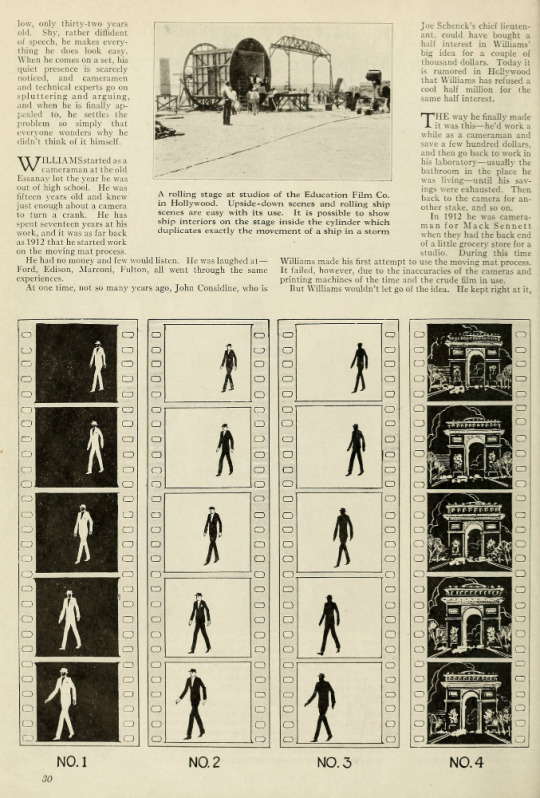
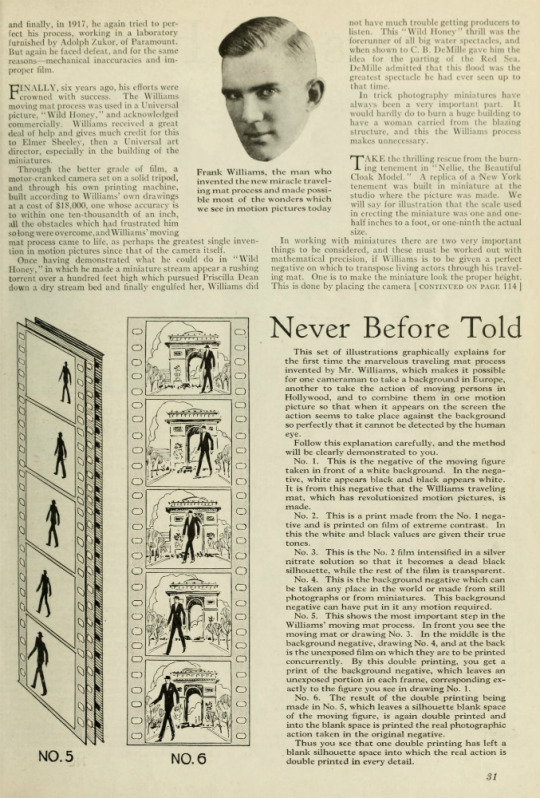
WILLIAMS started as a cameraman at the old Essanay lot the year he was out of high school. He was fifteen years old and knew just enough about a camera to turn a crank. He has spent seventeen years at his work, and it was as far back as 1912 that he started work on the moving mat process.
He had no money and few would listen. He was laughed at—Ford, Edison, Marconi, Fulton, all went through the same experiences.
At one time, not so many years ago, John Considine, who is Joe Schenck's chief lieutenant, could have bought a half interest in Williams' big idea for a couple of thousand dollars. Today it is rumored in Hollywood that Williams has refused a cool half million for the same half interest.
THE way he finally made it was this—he'd work a while as a cameraman and save a few hundred dollars, and then go back to work in his laboratory—usually the bathroom in the place he was living—until his savings were exhausted. Then back to the camera for another stake, and so on.
In 1912 he was cameraman for Mack Sennett when they had the back end of a little grocery store for a studio. During this time Williams made his first attempt to use the moving mat process. It failed, however, due to the inaccuracies of the cameras and printing machines of the time and the crude film in use.
But Williams wouldn’t let go of the idea. He kept right at it, and finally, in 1917, he again tried to perfect his process. working in a laboratory furnished by Adolph Zukor, of Paramount. But again he faced defeat, and for the same reasons—mechanical inaccuracies and improper film.
---
Photo caption: A rolling stage at studios of the Education Film Co. in Hollywood. Upside-down scenes and rolling ship scenes are easy with its use. It is possible to show ship interiors on the stage inside the cylinder which duplicates exactly the movement of a ship in a storm
[The rolling stage was used for lots of imaginative and comedic sequences in shorts and features. In the Lupino Lane short Movieland (1926), there’s a bit that shows the stage in action. Here’s a link to that specific scene, but the whole short is a lot of wacky fun and I recommend watching the full film!
Another illustration of how the rolling stage can be put to use is in When the Clouds Roll By (1919):


---
FINALLY, six years ago, his efforts were crowned with success. The Williams moving mat process was used in a Universal picture, "Wild Honey," and acknowledged commercially. Williams received a great deal of help and gives much credit for this to Elmer Sheeley, then a Universal art director, especially in the building of the miniatures.
Through the better grade of film, a motor-cranked camera set on a solid tripod, and through his own printing machine, built according to Williams' own drawings at a cost of $18,000, one whose accuracy is to within one ten-thousandth of an inch, all the obstacles which had frustrated him so long were overcome and Williams' moving mat process came to life, as perhaps the greatest single invention in motion pictures since that of the camera itself.
Once having demonstrated what he could do in "Wild Honey," in which he made a miniature stream appear a rushing torrent over a hundred feet high which pursued Priscilla Dean down a dry stream bed and finally engulfed her, Williams did not have much trouble getting producers to listen. This "Wild Honey" thrill was the forerunner of all big water spectacles, and when shown to C.B. DeMille gave him the idea for the parting of the Red Sea. DeMille admitted that this flood was the greatest spectacle he had ever seen up to that time.
[Unfortunately, Wild Honey (1922) is currently presumed lost and I was unable to find any depiction of Priscilla Dean fleeing from a torrent of water. As noted above however, there are quite a few extant films that also used Williams’ moving matte process.
In case you were wondering, I put $18,000 through an inflation calculator and it is equivalent to more than $315,000 in 2023 money!]
In trick photography miniatures have always been a very important part. It would hardly do to burn a huge building to have a woman carried from the blazing structure, and this the Williams process makes unnecessary.
TAKE the thrilling rescue front the burning tenement in "Nellie, the Beautiful Cloak Model." A replica of a New York tenement was built in miniature at the studio where the picture was made. We will say for illustration that the scale used in erecting the miniature was one and one-half inches to a foot, or one-ninth the actual size.
In working with miniatures there are two very important things to be considered, and these must be worked out with mathematical precision, if Williams is to be given a perfect negative on which to transpose living actors through his traveling mat. One is to make the miniature look the proper height. This is done by placing the camera the proper distance from the miniature (of course much closer than if it were a real building), and shooting from a lower level. The other is called timing. For example, if a miniature tree is to fall and the camera set-up is close enough and low enough to give the miniature the proper height when it is seen on the screen, then you must be careful of the speed with which it falls.
A little tree falls rapidly—a big tree slowly. And here is where the timing enters. Ultra speed cameras are used. The faster you crank the more pictures you get per second, and the slower the thing seems to move when you see it on the screen. You have all seen slow-motion pictures. These were made with slow-motion cameras, or what are more commonly termed ultra-speed cameras. And it is through this slow motion photography that the little tree is made to fall at the proper speed to be the big tree it represents, or the miniature stream is made to run at the proper speed for a giant river.
And so to get back to the fire which is still threatening "Our Nell." A torch is applied to the miniature tenement. At the proper count little invisible wires tied to window sashes are pulled and burning brands crash to the street below. And all the time the cameras, driven by motors at the proper speed, placed at the right distance from the conflagration and almost flat on the floor, are grinding away and recording this great fire.
[Nellie, the Beautiful Cloak Model (1924) is extant, with a print located at Gosfilmofond, but the film is not readily accessible. However, a depiction of the burning building sequence appears on an advertisement for the film:
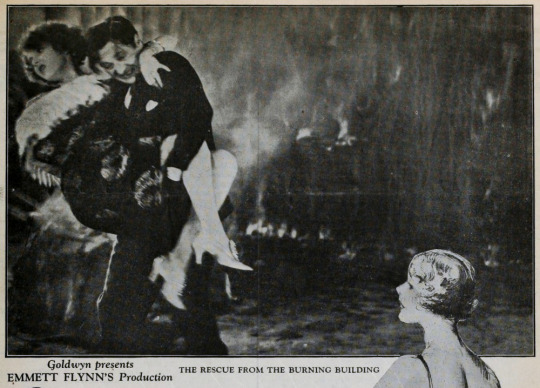
from Film Daily, 28 February 1924]
OVER on some other part of the lot, and at any time which suits the director's convenience, T. Roy Barnes, with Miss Windsor in his arms, dashes through a black velvet door and down a street backed with more black velvet.
Two things must be remembered, however. The actors must come out of the velvet door at the right spot and at the right time or "count." This is necessary so that Williams can match up the fire negative, which is the background with action in it, with the negative of Miss Windsor and Barnes, which becomes the moving mat.
The remainder is simple, and is done by Williams and his printing process over at his laboratory.
On the screen you see Barnes dashing from a burning tenement with Miss Windsor in his arms while, in reality, neither of the actors has been close enough to a fire to singe a single eyelash.
Blanche Sweet's rescue of Colman in "The Supreme Moment" was worked out in the same manner as this, as have been most other burning building thrills in pictures made in the last few years.
[His Supreme Moment (1925) is presumed lost and unfortunately I was unable to locate a depiction of the burning building rescue mentioned here.]
Now for the destruction of Pontius Pilate's palace with the struggling mass crushed beneath, in "Ben Hur." Of course the palace was done in miniature, while the people did their acting out on the lot, where the street was built with a dead white backing. Again the timing had to correspond with that in the falling of the palace.
The throng of people was lined up and rehearsed. Two lines were drawn in the street a fixed distance apart—which represented the space where the ruins of the palace would fall, and the throng was sent dashing wildly down the street. At a fixed signal, all caught between the two marks fell flat on the ground. Those who had not reached the first line halted and registered terror. Those who had passed the second mark fled on, looking back and also registering terror. You see, those caught between the two marks were the people buried under the debris of Pilate's palace—those on either side had escaped.

Then came the trick printing with the two negatives, with considerable painting out of those who had fallen flat between the two lines, and you have the palace falling on the panic-stricken throng in the street. The accompanying drawings will help you to visualize this.
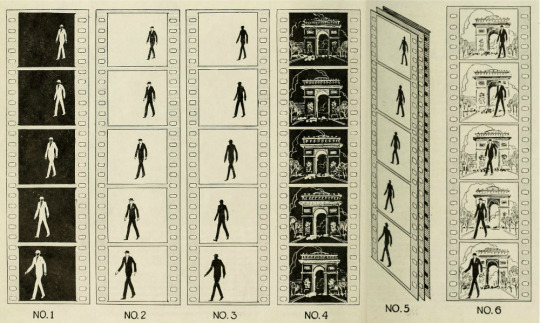
Never Before Told
This set of illustrations graphically explains for the first time the marvelous traveling mat process invented by Mr. Williams, which makes it possible for one cameraman to take a background in Europe, another to take the action of moving persons in Hollywood, and to combine them in one motion picture so that when it appears on the screen the action seems to take place against the background so perfectly that it cannot be detected by the human eye.
Follow this explanation carefully, and the method will be clearly demonstrated to you.
No. 1. This is the negative of the moving figure taken in front of a white background. In the negative, white appears black and black appears white. It is from this negative that the Williams traveling mat, which has revolutionized motion pictures, is made.
No. 2. This is a print made from the No. 1 negative and is printed on film of extreme contrast. In this the white and black values are given their true tones.
No. 3. This is the No. 2 film intensified in a silver nitrate solution so that it becomes a dead black silhouette, while the rest of the film is transparent.
No. 4. This is the background negative which can be taken any place in the world or made from still photographs or from miniatures. This background negative can have put in it any motion required.
No. 5. This shows the most important step in the Williams' moving mat process. In front you see the moving mat or drawing No. 3. In the middle is the background negative, drawing No. 4, and at the back is the unexposed film on which they are to be printed concurrently. By this double printing, you get a print of the background negative, which leaves an unexposed portion in each frame, corresponding exactly to the figure you see in drawing No. 1.
No. 6. The result of the double printing being made in No. 5, which leaves a silhouette blank space of the moving figure, is again double printed and into the blank space is printed the real photographic action taken in the original negative.
Thus you see that one double printing has left a blank silhouette space into which the real action is double printed in every detail.
---
The rescue of Doris Kenyon, which is also illustrated by the artist, was accomplished in this manner. One negative was shot of a very real and very steep precipice, the cameramen suspended on a platform far out over the edge to get the proper angle. Another negative was shot of Miss Kenyon's horse racing madly along what looked like a fence—but what was the inevitable white drop. Doris and the horse had to reach a certain mark at a certain count—for over at the precipice there had been rocks and dirt released at a certain count—the horse bad to rear, and Colman had to reach the frenzied beast, starting from outside the camera line, and he, too, must arrive on the right count. There could be no waiting for man or horse. They took it perhaps forty times before everything was exactly right, and then the two negatives (the precipice background and the moving mat) were ready for the printing wizard, and audiences got a great thrill.
[A Thief in Paradise (1925) is almost entirely lost. I profiled the film in my series Lost, but Not Forgotten in 2023.]
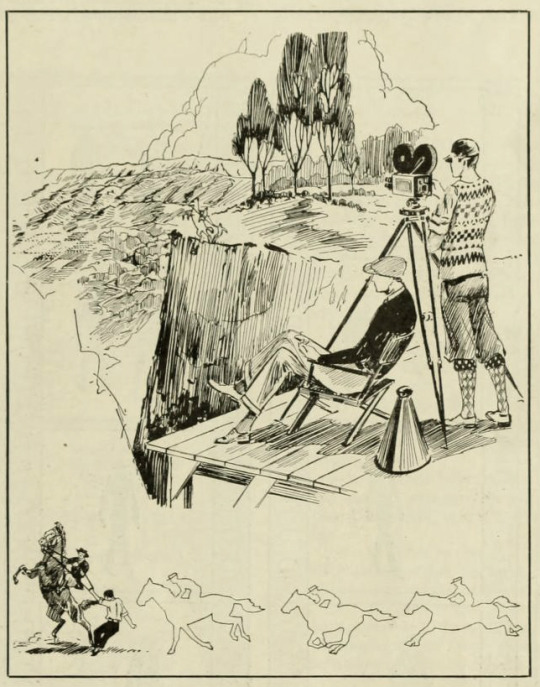
Photo caption: These two drawings explain how the runaway horse thrill in George Fitzmaurice's "A Thief in Paradise" was made. The upper drawing shows the cameraman getting his shots of a very steep and very real precipice. It also has the horse with its rider and the rescuer sketched in on the edge of the precipice where it actually appears in the picture.
The lower drawing shows the run that was made before the dead white background, with the horse rearing and Ronald Colman coming to Doris Kenyon's rescue.
The upper drawing was the background negative and the lower drawing the moving mat negative, and by the Williams' process the rearing horse, rider and Colman seemed to be actually placed on the brink of the precipice
---
You remember the mountain of water pursuing Conway Tearle in "The Great Divide." Of course they shot the torrent in miniature. Conway and his horse made their hairbreadth dash on a dark night and in an artificial rainstorm with nothing but a director threatening —then, although they did have quite a time making the steed climb a slippery and sloping wooden bridge, which was out on the back lot. Then up in Mr. Williams' laboratory, they finished one of the greatest thrills ever witnessed.
[While The Great Divide (1925) is thankfully extant at Cinemateket-Svenska Filminstitutet, it’s not easily accessible and I was unable to find a depiction of the effect.]
And the marvelous battle scenes in "The Big Parade." There were the big guns tearing huge craters in No Man's Land made on one negative, and the boys marched on and on and on in the other negative, and Mr. Williams brought them together in his printing laboratory. However, it was by no means as easy as it sounds, for this was one of the hardest pieces of moving mat printing ever accomplished.

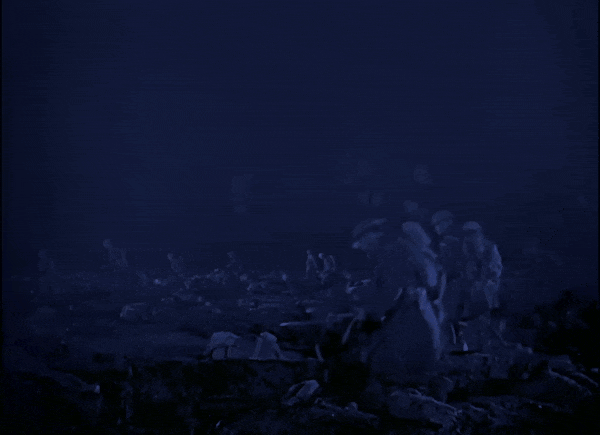

SO critical is the public that the building, photographing and printing of these miniatures must be of the very highest type of workmanship obtainable. It might be interesting to know that this work in "The Big Parade" alone cost approximately $70,000 for the background negative and the moving mat negative. The miniature battlefield was about one hundred thirty-five feet long and more than seven thousand miniature shells were fired in a period of forty seconds.
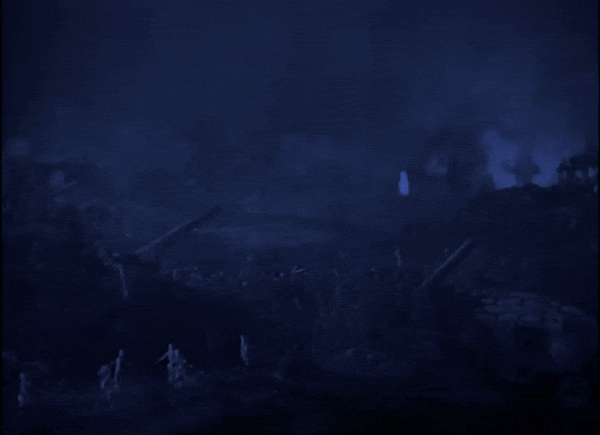



On another picture—"The Barrier"—which shows a fierce storm at sea, icebergs, and a ship caught and crushed in an ice floe, more than $85,000 have been spent to create these illusions.
[The Barrier (1926) is unfortunately presumed lost and I wasn’t able to find a depiction of this effect.]
Mr. Waller, technical camera expert of the Famous Players Long Island Studio, had never seen a cyclone; yet he was instructed to produce one for D. W. Griffith's picture, "That Royle Girl." Mr. Waller did extensive research work on the subject, and then made one to experiment with. A scientific knowledge of the working of the law of gravity, by the way, is necessary to create this phenomenon of nature.
[That Royle Girl (1925) is also presumed lost, and without film footage of this sequence there’s not really a way to know how the cyclone looked in the film. However, I do think the image highlighted in the advertisement below is likely from the cyclone sequence.
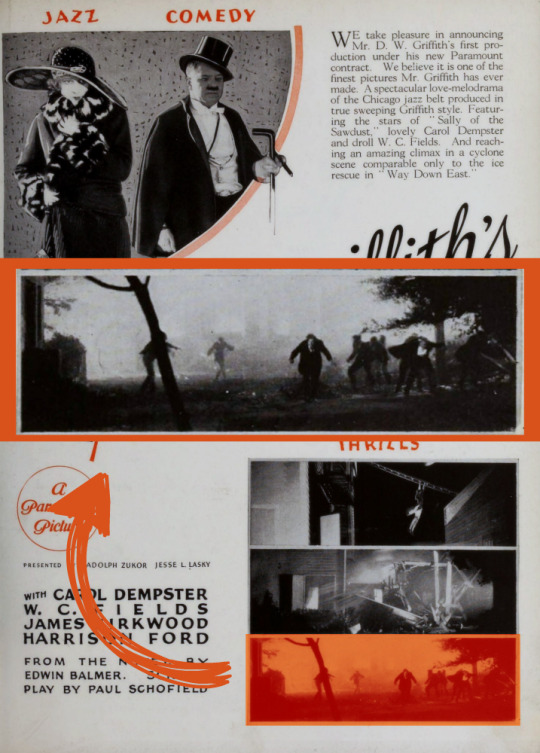
from Motion Picture News, 21 November 1925]
In the basement of the studio Mr. Waller connected up three vacuum cleaners. With three suctions of air and some dust, he made a tiny cyclone. This was photographed in slow motion so that the camera and technical crew might study the formation and activity of the cone.
From his observations of the film, Mr. Waller was able to prepare the series of wash drawings which, photographed in animated cartoon fashion, represented the action of the cyclone's cone in this sequence of the picture.
Several hundred drawings had to be made, each one depicting gradually the advance of the cone toward the Inn, which it finally demolishes. These were photographed in rotation on motion picture negative, and this negative double exposed on the 180-foot miniature scene containing the houses and trees. Thus we got a very good illusion of the cone of a cyclone advancing over a village and sweeping houses and trees out of its path.
[I wonder if/hope that some of these drawings have survived!]
The animated cartoon idea was also used in "A Kiss for Cinderella," when the pumpkin and mice change into the coach and four. The first few feet of the sequence showed real mice and pumpkin; from then on 256 wash drawings of the gradual transformation were photographed in rotation and gave the impression of being animated.
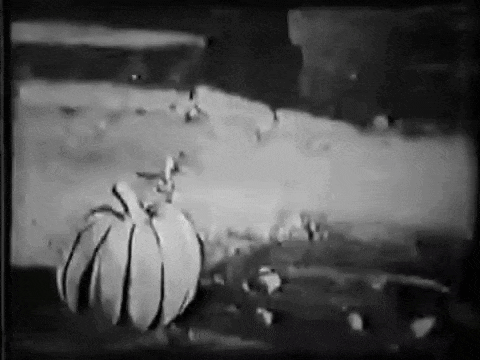
Double exposures of one actor playing two parts is the oldest and most familiar camera trick to the fans.
Just recently, however, has it been perfected to the point where the actor's two screen shadows can light each other's cigarettes and shake hands.
Tom Meighan, you recall, did this in Irish Luck."
AN invisible line from top to bottom divides each frame of the negative in half. One half at a time is exposed, photographing one half of the set.
Tom appears as Lord Fitzhugh on the left half, and as Tom Donohue on the right half. If you remember. Tom's two shadows are sitting side by side on a divan in the instance of the cigarette lighting. Fitzhugh leans over and gets a light from Donahue's cigarette. The illusion is perfect. But the cigarette from which his lordship really got the light was tacked onto a chair just outside the line, on the half of the set not being photographed at that moment. Only the lighted end of the cigarette projects into Fitzhugh's half of the picture.
[Irish Luck (1925) is extant at Eastman House, but it’s not currently easily accessible. I wasn’t able to find a depiction of this split-screen effect.]
Then when Donahue's half of the scene was being filmed, Tom leans forward and holds his cigarette in exactly the spot where the chair had been, the lighted end being outside his half of the picture. Think of the perfect matching this requires!
It is done this way. As Lord Fitzhugh performs on one side of the set, the director times his actions, counting the seconds out loud. He knows just where his lordship's right arm is, for instance, at the sixteenth second. When Donahue begins to perform on the other side of the set, his arm must be in a corresponding position at the sixteenth second. Tricky.
A thrilling moment in "Aloma of the South Seas," Gilda Grey's new picture, occurs when a shark eats a sailor. If you want this thrill, you naturally have to take it synthetic.
The shark cost $3,000. It was made of flexible rubber, and its insides consisted of a maze of electric wiring. Outside the body were several buttons which the actor could operate in his fight with the shark. It swims, wiggles its tail and bites electrically.
[Aloma of the South Seas (1926) is presumed lost and I wasn’t able to find images of the shark described here. However, as consolation, here is a photo from American Cinematographer of the film’s cinematographer Harry Fishbeck shooting on location in Puerto Rico:
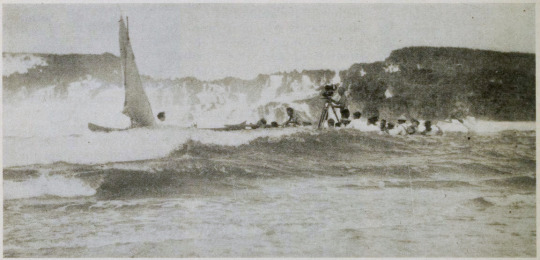
from American Cinematographer, February 1926]
I guess most of the suffering for art is done by the actors who tie themselves into knots to create the illusion of paralysis, amputated legs and so on. John Gilbert is shown in the last reels of "The Big Parade" with an amputated leg. Jack Barrymore in "The Sea Beast," also does it. It is merely a painful process of strapping the foreleg back. In "The Street of Forgotten Men," with Percy Marmont, a very lucid expose of cripple fakes is shown. Marmont had his arm strapped to his back for hours at a stretch during the filming of this picture. It hurts the first fifteen minutes, Percy said. After that the arm becomes numb.
A vigorous massage is necessary to bring it back to life, but it doesn't feel normal for weeks, Percy says.
Lon Chaney has his tricks of deformity down so pat that they are almost painless to him now.
#1920s#1910s#1926#classic film#classic movies#film#american film#my edits#silent film#my gifs#silent movies#silent era#silent cinema#cinema#film history#history#Roy Pomeroy#Frank Williams#Film Art#How'd They Do It#photoplay#lantern
63 notes
·
View notes
Text
~ Monthly BL Breakdown: May 2024 ~
🏳️🌈 Happy Pride Month!!! 🏳️🌈
Disclaimer: ALL shows can be streamed here or here, as well as on Youtube and other platforms. For more info on where to watch what, check out this post!
New breakdowns are coming at the end of every month - feel free to add stuff! -> previous breakdowns

What came out this month? (green = seen/currently watching)
🌟 You Made My Day (starring Tar A. and Bom T. from I Will Knock You) - May 3rd (Thailand)
🌟 Inverse Identity / Upside Down - Mary 3rd (China)
🌟 Wandee Goodday - May 4th (Thailand) ✅
🌟 Dear Miss Becky - May 6th (Philippines)
🌟 Deep Night Special Episode - May 9th (Thailand)
🌟 A Balloon's Landing - May 10th (Taiwan)
🌟 City of Stars: Special Episode - May 10th (Thailand, cinema release)
🌟 The Time of Fever (Unintentional Love Story spinoff) - May 15th (South Korea)
🌟 Blossom Campus - May 16th (South Korea)
🌟 OMG! Vampire - May 19th (Thailand)
🌟 Pray in Love - May 20th (Taiwan)
🌟 Manji Reverse - May 24th (Japan)
🌟 My Biker 2 - May 28th (Thailand)
🌟 Knock Knock Boys - May 30th (Thailand) ✅
🌟 Anti Reset Special - May 31st (Thailand)
Monthly Likes / Dislikes
❣️ My Stand-In - I've been liking this a lot and it's probably my favorite bl from this year so far. I was mostly skeptical of the reincarnation trope as I usually don't like that but I like where it's going. The storytelling is excellent, it's comprehensible and sends such good messages, it's subtle, not as in-your-face as other shows, they're not rehashing the same things and every character is believable and well-shaped, down to the smallest side role. The characters are flawed but so well-written that it's just a joy to witness them develop. That being said I wanna give a big shoutout to whoever was in charge of casting because the lineup is really top-tier lol. Every character is on-point thanks to their respective actor; Up is doing so well and also Poom is a very pleasant surprise. I love how expressive he is and him and Up work extremely well as a team imo. Also Mek as Tong is a good choice. Almost forgot what a truly good production looked like lmao. I'm in awe.
New series & movie announcements
🎥 Some Secrets in High School (mini series) - Date TBA (Thailand)
🎥 Street Fight (movie) - Date TBA (Thailand)
🎥 See Your Love - Date TBA (Taiwan)
🎥 Century of Love - Date TBA (Thailand)
🎥 Allure of the Siren - Date TBA (Thailand)
🎥 Takara's Treasure - Coming July 1st (Japan)
🎥 Air Moment (starring Earth T. & others) - Date TBA (Thailand)
🎥 The Paradise of Thorns - Coming August 2024 (Thailand)
🎥 Your Sky (starring Thomas & Kong, winners of the DMD reality program Friendship the Reality) - Date TBA (Thailand)
🎥 I Hear the Sunspot (remake) - Date TBA (Japan)
🎥 My Idol - Coming August 2024 (South Korea)
🎥 Khemjira - Date TBA (Thailand)
Other news from the BL world
❗️ In a week-to-week-release, Be On Cloud announced the cast of the upcoming BL 4 Minutes: Bible Wichapas, Jes Pipat, Bas Asavapatr, Job Yosatorn, Fuaiz Thanawat, Mio Athens, Jet Jetsadakorn & Jjay Patiphan. A release date, as well as further information has not been disclosed.
❗️After the announcement of OhmFluke being the lead actors in the upcoming Korean BL Surfing, their respective managements released a statement saying the news were false and that there was never any contact between the companies nor a request for permission to issue the news.
❗️The annual KAZZ awards were held on May 14th. The following BL actors/productions won:
Net Siraphop - Actor of the Year
Bed Friend - Series of the Year
Pit Babe - Kazz Magazine Favorite Award
❗️ The 20th Komchadluek Awards were held on May 28th. The following BL actors/productions won:
Zee P. - Most Popular Actor
Nunew C. - Best International Singer
Fourth N. - Best Rising Star
JimmySea - Best Couple
❗️ Actor JJ Radchapon has been announced as Net's new partner in the upcoming BL Love Upon a Time. His original partner James S. previously dropped out of the project to focus on his music career. Shooting will begin soon.
❗️ Actors Kaownah Kittipat and Max Nattapol have been announced as the BL side couple in the upcoming period GL drama Mom Pet Sawan.
❗️ Actor Tang Chinadis has announced his departure from the upcoming BL Jack & Joker. He withdrew from the project following accusations of physical abuse from his ex-girlfriend Prigkhing S. (formerly with GMMTV)
❗️ After accusations of domestic violence against his ex-girlfriend, the charges against GMMTV actor Pawin Thanik have been dropped. The company released a statement saying both parties requested a mediation, after which they came to a settlement where both cases were dismissed. Pawin had previously been placed on work probation and withdrew from the BL We Are amongst other projects.
Upcoming series & movies for June
👉🏻 My Love Mix-Up - June 6th (Thailand)
👉🏻 Love Sea - June 9th (Thailand)
👉🏻 SunsetxVibes - June 15th (Thailand)
👉🏻 The Rebound - June 26th (Thailand)
👉🏻 Blue Boys Part 2 - June TBA (South Korea)
#doreens monthly bl breakdown#thai bl#bl drama#upcoming bl#update#bl news#it has been another month ladies and gays#my personal highlights: MSI obvs bc its amazing also max and kaownah???? hold tf up lmao#what is happening#also the pawin thing...... idk#like okay the charges were dropped but was he actually proven innocent???#sounds more like they called a truce idk#anyway#im kinda looking foward to love sea dont tell anyone#i missed the mame madness lmao
45 notes
·
View notes
Text
Has anyone else thought about what songs they or your mcs and ocs would sings during karaoke night with the LOV! And Mary dragged Kai along? While Kai dragged Chrono just he didn't wanna go alone! Just me? XD What would ya'll pick? ;)

Mary: "Decode" by Paramore, "Give a Reason" by Megumi Hayashibara (Slayers NEXT op), "Dearest" by Ayumi Hamasaki (Inuyasha ed 3), and "Old Souls" from Phantom of The Paradise, "Zombie" by Natalia Kills
Mary and Toga: "Sleeping Instinct" by Yurika (Beastars Ending 2), "Again" by Yui ( Fullmetal Alchemist: Brotherhood - Op 1), "Gurenge" by LiSA, "In Chains" by Miku Appenda, and "Mz. Hyde" by Halestorm
Toga: "Usseewa" by Ado, "Can't By Tamed" by Miley Cyrus, and "Gimme Gimme" by Brittany Spears, "The Listening" by Lights
Shiggy: "E for Extinction" by Thousand Foot Krutch, and "Bloody Power Fame" by coldrain
Dabi: "Twisted" by MISSO, "Back From the Dead" by Skillet, "Play With Fire" (feat. Yacht Money) by Sam Tinneszm, "Behind Blue Eyes" by Limp Bizkit, "Vanilla" by Gackt, and "Bad Things" - Jace Everett
Shiggy and Dabi: "Pain" by Three Days Grace, and "Faceless" by RED
Spinner: "Rise" by Skillet, "I Am All of Me" by Crush 40
Twice: "Paranoid Doll" by GACKT, "Erase My Scars" by Evans Blue, and "Crawl" by Breaking Benjamin
Twice and Toga: Insanity (Vocaloid)
Mr Compress: "House of Memories" by Panic! At The Disco and "Dying Wish" by Tasuku Hatanaka (Moriarty the Patriot by op 1), and "Getsusekai" by BUCK TICK (Nightwalker OP)
Mr Compress and Twice: "The Other Side" from The Greatest Showman
Magne: "Baby One More Time" by Brittany Spears and "If I Had You" by Adam Lambert
Magne, Toga and Mary: "Girls Just Wanna have Fun" and "Bad Romance" by Lady Gaga, "Cinderella" by The Cheetah Girls, "SPLASH FREE" from Free! Iwatobi Swim Club ED, "Sexy Naughty Bitchy" by Tata Young, and "Starstruck" by Lady GaGa
Magne and Mary: "Gimme More" by Bodybangers ft. Victoria Kern, "Buttons" by The Pussycat Dolls, and "Dressin' Up" by Katy Perry
Everyone (pff, Mary begged; they can't say no to her XD): "Enemy" by Imagine Dragons & JID, "Riot" by Three Days Grace, "Perfect Life" by RED, and "It’s My Party" (Obey Me! Ending Theme)
Dabi, Spinner and Twice: "War Child" by Hollywood Undead (Dabi dragged Spinner, he's blushing hard, poor baby)
Overhaul: "Madness" and "Undisclosed Desires" by Muse, "Twisted Hearts" by Tasuku Hatanaka (Moriarty the Patriot by op 2), and "Sakura Falling - Yohio
Chrono: "Silent Scream" by Cinema Bizarre, "Hot Mess" by Cobra Starship (Hari had a few drinks)
Overhaul, Dabi and Tomura: "Kamisama HELP!" from Kamisama Hajimemashita, "JEALOUSNESS" from Brothers Conflict, and "SPECIALZ" By King Gnu (JJK S2 Op2)
Overhaul and Dabi: "Secret Zone" from BAD MEDICINE-INFECTIOUS TEACHERS OP
Hahah XD I had to have our lovesick Villains all sing together, mhwhaha (gonna tease and torment my boys)
----------------
Not gonna lie.... Twice, Spinner and Chrono were hard to think of songs for... aside from disney songs! That's a whole another crack fic idea.
I was overthinking again, pff, what's new? XD Scrolling through my music playlists, listening to songs and trying to find the right songs... this took me 2 hours X///////////x Whoops
Trying to make sure everyone got at least 1 song or 2! Then the duets and whatnot!

@togeandmegumilover @fanofflames @slayfics @dabislittlemouse @chainslobber @staitc-rj @fabled-lady-twilla
#league of villains#shie hassaikai#cannon x oc#crack fic idea#karaoke night with LOV#karaoke night with Shie Hassaikai#Overhaul#Dabi#Toga#Spinner#Twice#Mr Compress#mha chronostasis#Magne#boku no hero academia#villain lover#my hero academia#fangirl#overhaul fangirl#dabi fangirl#villainess oc x canon
17 notes
·
View notes
